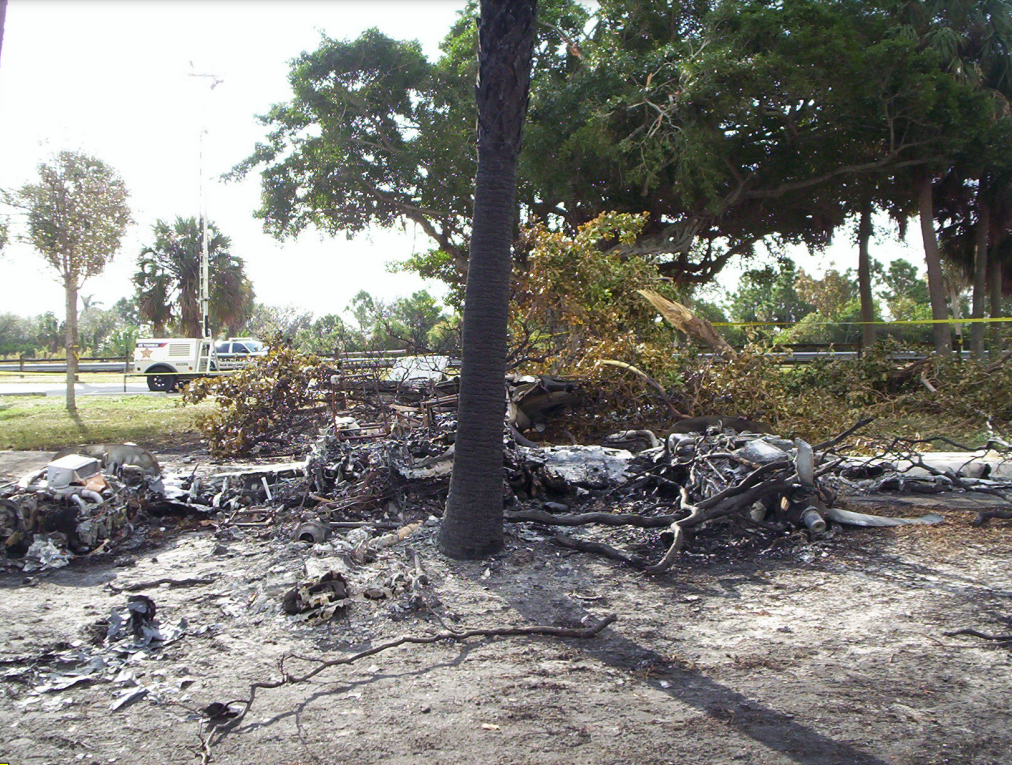
ASN Wikibase Occurrence # 151103
This information is added by users of ASN. Neither ASN nor the Flight Safety Foundation are responsible for the completeness or correctness of this information.
If you feel this information is incomplete or incorrect, you can submit corrected information.
| Date: | Saturday 8 December 2012 |
| Time: | 13:34 |
| Type: |  Cessna 421C Golden Eagle III |
| Owner/operator: | Subway Development of Southeast Florida Inc |
| Registration: | N297DB |
| MSN: | 421C0826 |
| Total airframe hrs: | 7040 hours |
| Engine model: | Teledyne Continental GTSIO-520 |
| Fatalities: | Fatalities: 1 / Occupants: 1 |
| Aircraft damage: | Destroyed |
| Category: | Accident |
| Location: | Lake Worth, FL -
 United States of America United States of America
|
| Phase: | Initial climb |
| Nature: | Private |
| Departure airport: | North Palm Beach County Airpark, FL (LNA) |
| Miami Airport, FL (TMB) | |
| Investigating agency: | NTSB |
| Confidence Rating: |
The twin-engine airplane was released to the pilot (who was also the airplane owner) after an annual inspection and repainting of the airplane had been completed. Before the accident flight, which was the second flight after maintenance, the pilot performed an engine run-up for several minutes before taxiing to the end of the departure runway for takeoff. According to witnesses, the airplane lifted off about halfway down the runway and initially climbed at a normal rate. Several witnesses then observed the airplane suddenly yaw to the left for 1 or 2 seconds, and the airplane's nose continued to pitch up before the airplane rolled left and descended vertically, nose-down, until it disappeared from view. One witness, a flight instructor, said, "The airplane just kept pitching up, and then it looked like a VMC [the airplane’s minimum controllable airspeed with only one engine operating] roll."
Examination of the left engine revealed signatures consistent with contact between the piston domes and the valves. The crankcase halves were separated and the No. 1 cylinder main bearing was rotated, and damaged and distorted severely, with bearing fragments located in the oil sump. Bearing material was also extruded from its steel backing. The No. 3 cylinder main bearing showed accelerated wear and wiping of the bearing material. Damage and signatures consistent with excessive heat due to oil starvation were observed on the No. 1 and No. 3 cylinder main bearing journals as well as the No. 1 and No. 2 cylinder connecting rod journals. The camshaft gear was also damaged, with five gear teeth sheared from the gear. A review of engine maintenance records revealed that no maintenance had been performed on the engine that would have required breaking of crankcase thru-bolt torques (such as cylinder removal) since its most recent overhaul, which was completed more than 3 years and 314 flight hours before the accident flight. The reason for the engine failure could not be determined because of the impact and postaccident fire damage.
Examination of the wreckage revealed that the landing gear was in the down and locked position, the left engine propeller blades were in the feathered position, and the left fuel selector valve was in the off position. Examination of the manufacturer's Pilot Operating Handbook revealed that if properly configured, with the landing gear retracted, the airplane would have been capable of a 500 foot-per-minute rate of climb with only one operating engine on the day of the accident. As found, the airplane was not configured in accordance with the after-takeoff checklist or the engine failure after takeoff checklist.
Probable Cause: The pilot's failure to follow established engine-out procedures and to maintain a proper airspeed after the total loss of engine power on one of the airplane’s two engines during the initial climb. Contributing to the accident was the total loss of engine power due to a loss of torque on the crankcase bolts for reasons that could not be determined because of impact- and fire-related damage to the engine.
Accident investigation:
 |
|
Sources:
NTSB
Location
Images:

Photo: NTSB
Revision history:
| Date/time | Contributor | Updates |
|---|---|---|
| 09-Dec-2012 03:25 | Alpine Flight | Added |
| 09-Dec-2012 13:32 | Geno | Updated [Time, Source, Narrative] |
| 09-Dec-2012 17:54 | RobertMB | Updated [Aircraft type, Narrative] |
| 17-Dec-2012 10:53 | Geno | Updated [Time, Destination airport, Source] |
| 21-Dec-2016 19:28 | ASN Update Bot | Updated [Time, Damage, Category, Investigating agency] |
| 28-Nov-2017 14:02 | ASN Update Bot | Updated [Operator, Other fatalities, Departure airport, Destination airport, Source, Narrative] |
| 19-May-2022 11:56 | Captain Adam | Updated [Operator, Other fatalities, Departure airport, Destination airport, Narrative, Photo] |
| 02-Jul-2022 19:07 | rvargast17 | Updated [Damage] |
Corrections or additions? ... Edit this accident description
The Aviation Safety Network is an exclusive service provided by:


 ©2024 Flight Safety Foundation
©2024 Flight Safety Foundation